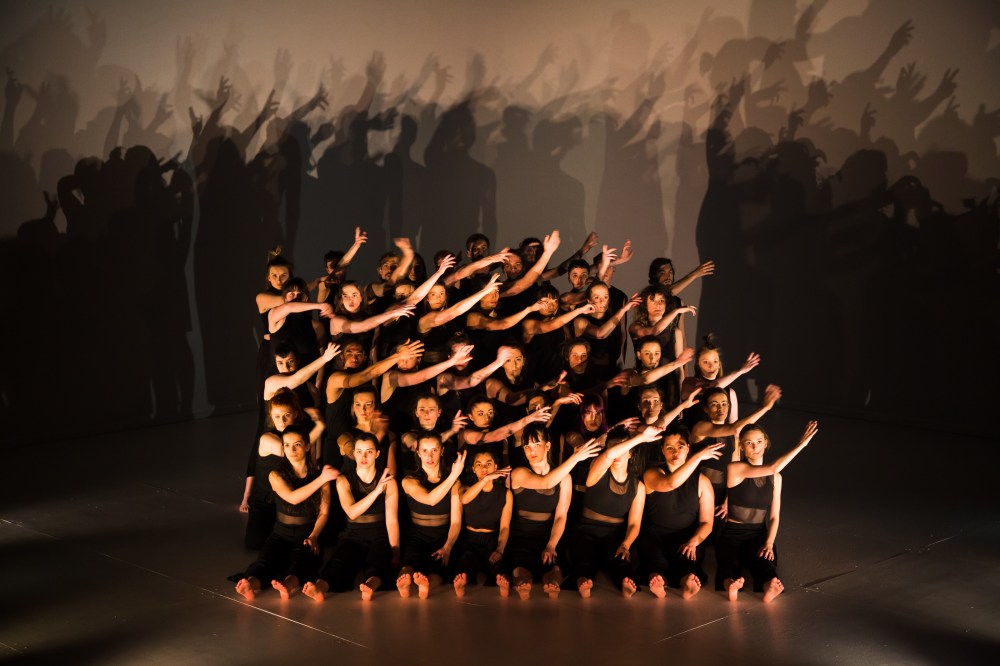Carriageworks, Sydney Festival, January 16
The short Sydney Festival season of Stephanie Lake’s Colossus has ended but the show is by no means over. Next month it will be seen at the Perth Festival and very likely beyond. Lake has said there are possible international engagements to come. Colossus premiered at the Melbourne Fringe in 2018 and last year featured in the Melbourne International Arts Festival program. This, obviously, is what gets known as a festival piece; something ambitious that needs the resources of a large organisation behind it. Colossus was choreographed for more than 40 dancers. No further explanation is needed. Well perhaps a little explanation. Colossus is usually described as having 50 dancers but it’s a handful fewer according to the cast sheet.

Whatever the number, it’s a lot. It’s rare to see an independent choreographer have the luxury of such forces at her disposal, although Lake has previously shown she can handle them. Her terrific piece for Queensland Ballet’s 2017 Bespoke program, Chameleon, proved that. Not that she’s any slouch with small forces either, as Double Blind showed in 2016.
Colossus starts in stillness. As the audience enters the dancers are already present, lying motionless on their backs, arranged in a circle. There is a thunderous clap and scores of arms and heads are raised in unison. Energy transfers from Robin Fox’s heartbeat-like score to the bodies and from one body to the next. Everyone is part of the pack, a separate being and at the same time a collective entity, like a flock of birds in flight or a herd of zebra on the move, the one member of the group always knowing where the others are in relation to themselves and acting in concert.
Their black attire looks self-effacing against the bright white surrounds and even though each costume (designed by Harriet Oxley) is different – a dress here, shorts there, meshes, cutouts, straps and so on – the overwhelming sense is of anonymity. Yes, some figures are taller, shorter or more muscular than others but one will never really know these people, even when Lake pulls a single person or a couple from the mass. They emerge and are then subsumed.

Several times Lake’s formal organisation of dancers into circles and lines explodes into a kind of chaos one could perhaps designate as freedom, but it looks as chilling as Colossus’s highly structured mass movements of people obeying disembodied instructions, ferocious marching, a mob chasing one person.
Lake does allow a few flashes of independence. In one brief section in the middle of this 50-minute work the dancers suddenly break ranks to mingle and chatter amongst themselves, as if taking a short breather. It’s a reminder that they are indeed human, doing what comes naturally, delightfully relaxed and cheerful. And as the piece nears its end, with the simplest of means Lake changes the atmosphere to one of understanding and acceptance within the group and, finally, individuality.

Integral to this optimistic conclusion are Fox’s sound design and Bosco Shaw’s eloquent lighting. Fox’s electronic scores are often uncompromisingly tough and spiky. Here there’s a more human quality, particularly in the incorporation of the dancers’ breathing and the percussive possibilities of their bodies. From Shaw there is a design that from time to time softens the harsh glare of black versus blinding white with illuminations that throw ghostly shadows. It’s a beautiful effect, but more than that. It speaks of the spirit within, no matter how oppressive, regimented or controlled life may seem.
Perth Festival, February 19-23